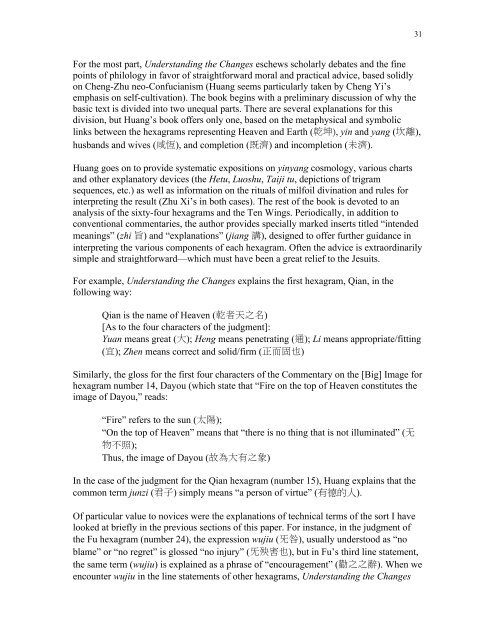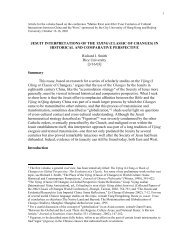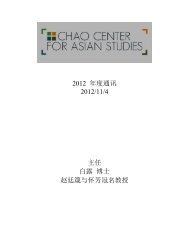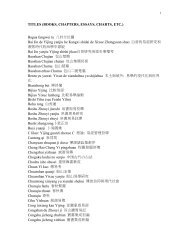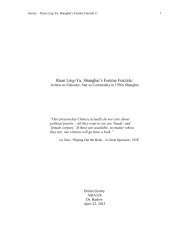Key Concepts of Fate and Prediction in the Yijing - Chao Center for ...
Key Concepts of Fate and Prediction in the Yijing - Chao Center for ...
Key Concepts of Fate and Prediction in the Yijing - Chao Center for ...
Create successful ePaper yourself
Turn your PDF publications into a flip-book with our unique Google optimized e-Paper software.
31For <strong>the</strong> most part, Underst<strong>and</strong><strong>in</strong>g <strong>the</strong> Changes eschews scholarly debates <strong>and</strong> <strong>the</strong> f<strong>in</strong>epo<strong>in</strong>ts <strong>of</strong> philology <strong>in</strong> favor <strong>of</strong> straight<strong>for</strong>ward moral <strong>and</strong> practical advice, based solidlyon Cheng-Zhu neo-Confucianism (Huang seems particularly taken by Cheng Yi’semphasis on self-cultivation). The book beg<strong>in</strong>s with a prelim<strong>in</strong>ary discussion <strong>of</strong> why <strong>the</strong>basic text is divided <strong>in</strong>to two unequal parts. There are several explanations <strong>for</strong> thisdivision, but Huang’s book <strong>of</strong>fers only one, based on <strong>the</strong> metaphysical <strong>and</strong> symbolicl<strong>in</strong>ks between <strong>the</strong> hexagrams represent<strong>in</strong>g Heaven <strong>and</strong> Earth (, y<strong>in</strong> <strong>and</strong> yang (),husb<strong>and</strong>s <strong>and</strong> wives (), <strong>and</strong> completion () <strong>and</strong> <strong>in</strong>completion ().Huang goes on to provide systematic expositions on y<strong>in</strong>yang cosmology, various charts<strong>and</strong> o<strong>the</strong>r explanatory devices (<strong>the</strong> Hetu, Luoshu, Taiji tu, depictions <strong>of</strong> trigramsequences, etc.) as well as <strong>in</strong><strong>for</strong>mation on <strong>the</strong> rituals <strong>of</strong> milfoil div<strong>in</strong>ation <strong>and</strong> rules <strong>for</strong><strong>in</strong>terpret<strong>in</strong>g <strong>the</strong> result (Zhu Xi’s <strong>in</strong> both cases). The rest <strong>of</strong> <strong>the</strong> book is devoted to ananalysis <strong>of</strong> <strong>the</strong> sixty-four hexagrams <strong>and</strong> <strong>the</strong> Ten W<strong>in</strong>gs. Periodically, <strong>in</strong> addition toconventional commentaries, <strong>the</strong> author provides specially marked <strong>in</strong>serts titled “<strong>in</strong>tendedmean<strong>in</strong>gs” (zhi ) <strong>and</strong> “explanations” (jiang ), designed to <strong>of</strong>fer fur<strong>the</strong>r guidance <strong>in</strong><strong>in</strong>terpret<strong>in</strong>g <strong>the</strong> various components <strong>of</strong> each hexagram. Often <strong>the</strong> advice is extraord<strong>in</strong>arilysimple <strong>and</strong> straight<strong>for</strong>ward—which must have been a great relief to <strong>the</strong> Jesuits.For example, Underst<strong>and</strong><strong>in</strong>g <strong>the</strong> Changes expla<strong>in</strong>s <strong>the</strong> first hexagram, Qian, <strong>in</strong> <strong>the</strong>follow<strong>in</strong>g way:Qian is <strong>the</strong> name <strong>of</strong> Heaven ()[As to <strong>the</strong> four characters <strong>of</strong> <strong>the</strong> judgment]:Yuan means great (); Heng means penetrat<strong>in</strong>g (); Li means appropriate/fitt<strong>in</strong>g(); Zhen means correct <strong>and</strong> solid/firm ()Similarly, <strong>the</strong> gloss <strong>for</strong> <strong>the</strong> first four characters <strong>of</strong> <strong>the</strong> Commentary on <strong>the</strong> [Big] Image <strong>for</strong>hexagram number 14, Dayou (which state that “Fire on <strong>the</strong> top <strong>of</strong> Heaven constitutes <strong>the</strong>image <strong>of</strong> Dayou,” reads:“Fire” refers to <strong>the</strong> sun ();“On <strong>the</strong> top <strong>of</strong> Heaven” means that “<strong>the</strong>re is no th<strong>in</strong>g that is not illum<strong>in</strong>ated” ();Thus, <strong>the</strong> image <strong>of</strong> Dayou ()In <strong>the</strong> case <strong>of</strong> <strong>the</strong> judgment <strong>for</strong> <strong>the</strong> Qian hexagram (number 15), Huang expla<strong>in</strong>s that <strong>the</strong>common term junzi () simply means “a person <strong>of</strong> virtue” ().Of particular value to novices were <strong>the</strong> explanations <strong>of</strong> technical terms <strong>of</strong> <strong>the</strong> sort I havelooked at briefly <strong>in</strong> <strong>the</strong> previous sections <strong>of</strong> this paper. For <strong>in</strong>stance, <strong>in</strong> <strong>the</strong> judgment <strong>of</strong><strong>the</strong> Fu hexagram (number 24), <strong>the</strong> expression wujiu (), usually understood as “noblame” or “no regret” is glossed “no <strong>in</strong>jury” (), but <strong>in</strong> Fu’s third l<strong>in</strong>e statement,<strong>the</strong> same term (wujiu) is expla<strong>in</strong>ed as a phrase <strong>of</strong> “encouragement” (). When weencounter wujiu <strong>in</strong> <strong>the</strong> l<strong>in</strong>e statements <strong>of</strong> o<strong>the</strong>r hexagrams, Underst<strong>and</strong><strong>in</strong>g <strong>the</strong> Changes


